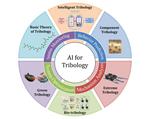Friction ( IF 6.8 ) Pub Date : 2024-03-12 , DOI: 10.1007/s40544-024-0879-2 Nian Yin , Pufan Yang , Songkai Liu , Shuaihang Pan , Zhinan Zhang

|
With remarkable learning capabilities and swift operational speeds, artificial intelligence (AI) can assist researchers in swiftly extracting valuable patterns, trends, and associations from subjective information. Tribological behaviors are characterized by dependence on systems, evolution with time, and multidisciplinary coupling. The friction process involves a variety of phenomena, including mechanics, thermology, electricity, optics, magnetics, and so on. Hence, tribological information possesses the distinct characteristics of being multidisciplinary, multilevel, and multiscale, so that the application of AI in tribology is highly extensive. To delineate the scope, classification, and recent trends of AI implementation in tribology, this review embarks on exploration of the tribology research domain. It comprehensively outlines the utilization of AI in basic theory of tribology, intelligent tribology, component tribology, extreme tribology, bio-tribology, green tribology, and other fields. Finally, considering the emergence of “tribo-informatics” as a novel interdisciplinary field, which combines tribology with informatics, this review elucidates the future directions and research framework of “AI for tribology”. In this paper, tribo-system information is divided into 5 categories: input information (I), system intrinsic information (S), output information (O), tribological state information (Ts), and derived state information (Ds). Then, a fusion method among 5 types of tribo-system information and different AI technologies (regression, classification, clustering, and dimension reduction) has been proposed, which enables tribo-informatics methods to solve common problems such as tribological behavior state monitoring, behavior prediction, and system optimization. The purpose of this review is to offer a systematic comprehension of tribo-informatics and to inspire new research ideas of tribo-informatics. Ultimately, it aspires to enhance the efficiency of problem-solving in tribology.
中文翻译:

摩擦学人工智能:现在和未来
人工智能(AI)凭借卓越的学习能力和快速的运算速度,可以帮助研究人员从主观信息中快速提取有价值的模式、趋势和关联。摩擦学行为的特点是对系统的依赖性、随时间的演变以及多学科耦合。摩擦过程涉及多种现象,包括力学、热学、电学、光学、磁学等。因此,摩擦学信息具有多学科、多层次、多尺度的鲜明特点,人工智能在摩擦学中的应用非常广泛。为了描述摩擦学中人工智能应用的范围、分类和最新趋势,本综述开始对摩擦学研究领域进行探索。全面概述了人工智能在摩擦学基础理论、智能摩擦学、零部件摩擦学、极限摩擦学、生物摩擦学、绿色摩擦学等领域的应用。最后,考虑到“摩擦信息学”作为摩擦学与信息学相结合的新兴跨学科领域的出现,本文阐明了“摩擦学人工智能”的未来方向和研究框架。本文将摩擦系统信息分为5类:输入信息(I)、系统固有信息(S)、输出信息(O)、摩擦学状态信息(T s)和导出状态信息(D s)。然后,提出了 5 类摩擦系统信息与不同人工智能技术(回归、分类、聚类和降维)之间的融合方法,使摩擦信息学方法能够解决摩擦学行为状态监测、行为等常见问题。预测、系统优化。本综述的目的是提供对摩擦信息学的系统理解,并启发摩擦信息学新的研究思路。最终,它希望提高摩擦学问题解决的效率。































 京公网安备 11010802027423号
京公网安备 11010802027423号